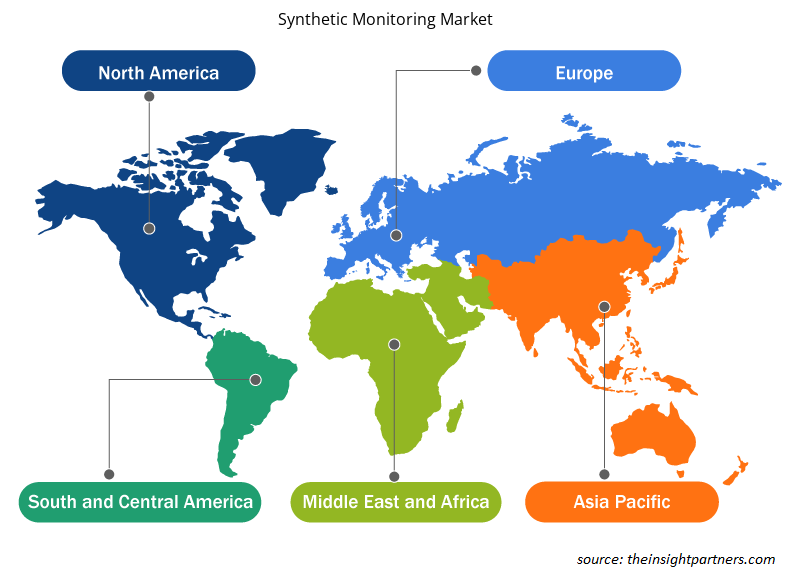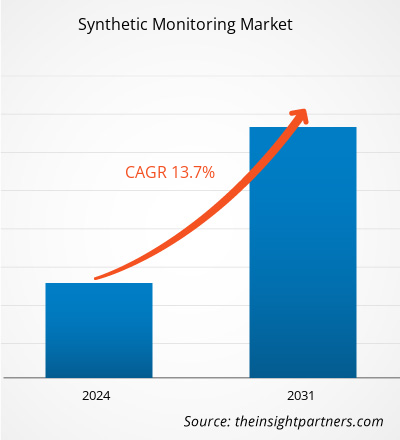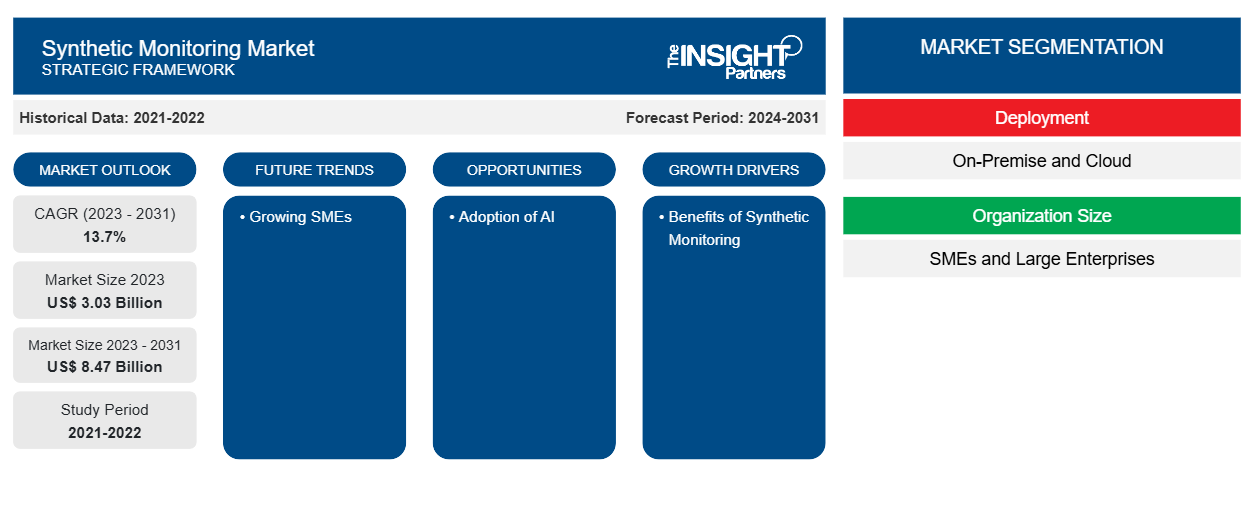Der Markt für synthetisches Monitoring soll von 3,03 Milliarden US-Dollar im Jahr 2023 auf 8,47 Milliarden US-Dollar im Jahr 2031 anwachsen. Der Markt wird voraussichtlich zwischen 2023 und 2031 eine durchschnittliche jährliche Wachstumsrate von 13,7 % verzeichnen. Die zunehmende Cloud-Nutzung und die zunehmende Digitalisierung werden wahrscheinlich weiterhin der Schlüssel zu den Trends auf dem Markt für synthetisches Monitoring sein.
Synthetisches Monitoring – Marktanalyse
Staatliche Unterstützung zur Stärkung der Geschäftsfähigkeit von KMU durch finanzielle Hilfen, Anreize und Initiativen kann zur Einführung von Softwarelösungen wie synthetischen Überwachungslösungen beitragen. Der wachsende Cloud-Markt ist einer der Hauptfaktoren, die den Markt für synthetische Überwachung antreiben, da die Cloud eine kostengünstige Lösung ist, die zur Einführung cloudbasierter synthetischer Überwachungslösungen durch mehrere große Unternehmen und KMU führt, was den Markt für synthetische Überwachung weiter antreibt.
Marktübersicht für synthetisches Monitoring
Synthetisches Monitoring bezieht sich auf die Verwendung von Software zur Simulation von Benutzerinteraktionen mit einem System. Die aus den simulierten Transaktionen gesammelten Daten werden dann analysiert, um zu bestimmen, wie das System funktioniert. Beispielsweise könnte synthetisches Monitoring verwendet werden, um zu bestimmen, ob eine Website die gewünschte Seitenladezeit, Reaktionszeit und Verfügbarkeit erreicht.
Passen Sie diesen Bericht Ihren Anforderungen an
Sie erhalten kostenlose Anpassungen an jedem Bericht, einschließlich Teilen dieses Berichts oder einer Analyse auf Länderebene, eines Excel-Datenpakets sowie tolle Angebote und Rabatte für Start-ups und Universitäten.
-
Holen Sie sich die wichtigsten Markttrends aus diesem Bericht.Dieses KOSTENLOSE Beispiel umfasst eine Datenanalyse von Markttrends bis hin zu Schätzungen und Prognosen.
Treiber und Chancen auf dem Markt für synthetisches Monitoring
Vorteile der synthetischen Überwachung zugunsten des Marktes
Mithilfe von synthetischen Überwachungslösungen kann der Endbenutzer vorhersagen, wie ein System auf Benutzeranforderungen reagiert, bevor tatsächliche Benutzer damit interagieren. Mithilfe der synthetischen Überwachung kann der Endbenutzer überprüfen, ob Systeme die Leistungs- und Verfügbarkeitsanforderungen erfüllen, bevor sie in Produktion gehen. In dieser Hinsicht ermöglicht die synthetische Überwachung eine proaktive Überwachung . Darüber hinaus ist die synthetische Überwachung nützlich, um die Reaktion eines Systems auf ungewöhnliche oder seltene Anforderungen auszuwerten, die möglicherweise nicht in den Daten erfasst werden, die aus von echten Benutzern initiierten Transaktionen gesammelt werden. Somit hilft die synthetische Überwachung dabei, die Systemleistung zu überprüfen und potenzielle Probleme zu identifizieren, bevor sie sich auf das Endbenutzererlebnis auswirken. Die synthetische Überwachung ermöglicht eine proaktive Überwachung und behebt Leistungs- und Verfügbarkeitsprobleme, bevor sie Produktionsanwendungen stören, wodurch die Endbenutzer ihr Kundenerlebnis verbessern können.
Wachsender KMU-Markt
Unternehmen verwenden synthetische Überwachungstools, um Unternehmensanwendungen zu überwachen. Diese liefern Informationen über die Betriebszeit und die Gesamtleistung kritischer Geschäftstransaktionen, indem sie mehrere Kundenaktivitäten simulieren. Diese Tools ermöglichen es Unternehmen, Leistungslücken zu schließen, die sich auf das Gesamterlebnis des Endbenutzers auswirken können. Die zunehmende Digitalisierung und staatliche Unterstützung für KMU fördern somit die Fähigkeit von KMU, Softwarelösungen einzuführen, um die Effizienz ihrer Arbeitsabläufe zu steigern. Darüber hinaus werden angesichts des Trends der digitalen Transformation zur Verbesserung der allgemeinen Betriebseffizienz und des Endbenutzererlebnisses in Zukunft mehr KMU synthetische Überwachungslösungen einführen.
Segmentierungsanalyse des Marktberichts zur synthetischen Überwachung
Wichtige Segmente, die zur Ableitung der Marktanalyse für synthetisches Monitoring beigetragen haben, sind Tinteneinsatz, Organisationsgröße, Überwachungstyp und Branche.
- Der Markt ist nach Bereitstellung in On-Premise und Cloud segmentiert. Das Cloud-Segment wird voraussichtlich mit der höchsten durchschnittlichen jährlichen Wachstumsrate wachsen.
- Basierend auf der Unternehmensgröße wird der Markt in KMU und Großunternehmen segmentiert. Das KMU-Segment wird voraussichtlich mit der höchsten durchschnittlichen jährlichen Wachstumsrate wachsen.
- Nach Überwachungstyp ist der Markt in API-Überwachung, SaaS-Anwendungsüberwachung, Überwachung mobiler Anwendungen und Webanwendungsüberwachung segmentiert . Das API-Überwachungssegment hatte im Jahr 2023 den größten Marktanteil.
- Der Markt ist branchenbezogen in BFSI, öffentliche Verwaltung, Einzelhandel, Gesundheitswesen, IT und Telekommunikation sowie andere Branchen unterteilt. Das Einzelhandelssegment dürfte die höchste jährliche Wachstumsrate aufweisen.
Synthetisches Monitoring – Marktanteilsanalyse nach geografischer Lage
Der geografische Umfang des Marktberichts zur synthetischen Überwachung ist hauptsächlich in fünf Regionen unterteilt: Nordamerika, Asien-Pazifik, Europa, Naher Osten und Afrika sowie Südamerika/Süd- und Mittelamerika.
Der asiatisch-pazifische Raum wird voraussichtlich die höchste durchschnittliche jährliche Wachstumsrate aufweisen. Die Verbreitung der Cloud-Technologie in der Region führt zum Marktwachstum der Region. Die wachsenden KMU in der Region treiben die Nachfrage nach Softwarelösungen in der Region an und fördern den Einsatz synthetischer Überwachungstechnologie. Die digitale Transformation in Schwellenländern wie Indien und China führt zur Einführung synthetischer Überwachungslösungen in verschiedenen Endverbraucherbranchen.
Regionale Einblicke in den Markt für synthetische Überwachung
Die regionalen Trends und Faktoren, die den Markt für synthetisches Monitoring im gesamten Prognosezeitraum beeinflussen, wurden von den Analysten von Insight Partners ausführlich erläutert. In diesem Abschnitt werden auch die Marktsegmente und die Geografie des synthetischen Monitorings in Nordamerika, Europa, im asiatisch-pazifischen Raum, im Nahen Osten und Afrika sowie in Süd- und Mittelamerika erörtert.

- Erhalten Sie regionalspezifische Daten zum Markt für synthetisches Monitoring
Umfang des Marktberichts zur synthetischen Überwachung
| Berichtsattribut | Details |
|---|---|
| Marktgröße im Jahr 2023 | 3,03 Milliarden US-Dollar |
| Marktgröße bis 2031 | 8,47 Milliarden US-Dollar |
| Globale CAGR (2023 - 2031) | 13,7 % |
| Historische Daten | 2021-2022 |
| Prognosezeitraum | 2024–2031 |
| Abgedeckte Segmente |
Nach Bereitstellung
|
| Abgedeckte Regionen und Länder |
Nordamerika
|
| Marktführer und wichtige Unternehmensprofile |
|
Dichte der Marktteilnehmer für synthetisches Monitoring: Die Auswirkungen auf die Geschäftsdynamik verstehen
Der Markt für synthetisches Monitoring wächst rasant, angetrieben durch die steigende Nachfrage der Endnutzer aufgrund von Faktoren wie sich entwickelnden Verbraucherpräferenzen, technologischen Fortschritten und einem größeren Bewusstsein für die Vorteile des Produkts. Mit steigender Nachfrage erweitern Unternehmen ihr Angebot, entwickeln Innovationen, um die Bedürfnisse der Verbraucher zu erfüllen, und nutzen neue Trends, was das Marktwachstum weiter ankurbelt.
Die Marktteilnehmerdichte bezieht sich auf die Verteilung der Firmen oder Unternehmen, die in einem bestimmten Markt oder einer bestimmten Branche tätig sind. Sie gibt an, wie viele Wettbewerber (Marktteilnehmer) in einem bestimmten Marktraum im Verhältnis zu seiner Größe oder seinem gesamten Marktwert präsent sind.
Die wichtigsten auf dem Markt für synthetisches Monitoring tätigen Unternehmen sind:
- Apica
- AppDynamics LLC
- Broadcom Inc.
- Dynatrace LLC.
- eG Innovations, Inc.
- IBM Corporation
Haftungsausschluss : Die oben aufgeführten Unternehmen sind nicht in einer bestimmten Reihenfolge aufgeführt.

- Überblick über die wichtigsten Akteure auf dem Markt für synthetisches Monitoring
Neuigkeiten und aktuelle Entwicklungen zum Markt für synthetisches Monitoring
Der Markt für synthetisches Monitoring wird durch die Erhebung qualitativer und quantitativer Daten nach Primär- und Sekundärforschung bewertet, die wichtige Unternehmensveröffentlichungen, Verbandsdaten und Datenbanken umfasst. Im Folgenden finden Sie eine Liste der Entwicklungen auf dem Markt:
- Im Juli 2023 führte Google Synthetic Monitoring ein, eine neue proaktive Überwachungsfunktion, die automatisierte Node.js-Skripte verwendet, um Benutzerinteraktionen mit einer Anwendung oder einem Dienst zu simulieren. Auf diese Weise können Sie die Verfügbarkeit, Konsistenz und Leistung Ihrer Webanwendungen, APIs und wichtigen Geschäftsabläufe regelmäßig aus der Perspektive eines echten Benutzers testen. Im November 2023 kündigte Google die allgemeine Verfügbarkeit von Synthetic Monitoring an. Darüber hinaus hat das Unternehmen mit dieser Einführung auch neue Funktionen für Synthetic Monitoring hinzugefügt. (Quelle: Google, Pressemitteilung, 2023)
- Im März 2022 wurde AppDynamics Synthetic Monitoring um Synthetic API Monitoring erweitert. Damit können ITOps und DevOps die Auswirkungen von API-Leistungs- und Verfügbarkeitsproblemen auf Geschäftsergebnisse und Benutzererfahrung minimieren. (Quelle: AppDynamics, Pressemitteilung, 2022)
Marktbericht zum synthetischen Monitoring – Umfang und Ergebnisse
Der Bericht „Marktgröße und Prognose für synthetisches Monitoring (2021–2031)“ bietet eine detaillierte Analyse des Marktes, die die folgenden Bereiche abdeckt:
- Marktgröße und Prognose auf globaler, regionaler und Länderebene für alle wichtigen Marktsegmente, die im Rahmen des Projekts abgedeckt sind
- Marktdynamik wie Treiber, Beschränkungen und wichtige Chancen
- Wichtige Zukunftstrends
- Detaillierte PEST/Porters Five Forces- und SWOT-Analyse
- Globale und regionale Marktanalyse mit wichtigen Markttrends, wichtigen Akteuren, Vorschriften und aktuellen Marktentwicklungen
- Branchenlandschaft und Wettbewerbsanalyse, einschließlich Marktkonzentration, Heatmap-Analyse, prominenten Akteuren und aktuellen Entwicklungen
- Detaillierte Firmenprofile
- Historische Analyse (2 Jahre), Basisjahr, Prognose (7 Jahre) mit CAGR
- PEST- und SWOT-Analyse
- Marktgröße Wert/Volumen – Global, Regional, Land
- Branchen- und Wettbewerbslandschaft
- Excel-Datensatz
Aktuelle Berichte
Erfahrungsberichte
Grund zum Kauf
- Fundierte Entscheidungsfindung
- Marktdynamik verstehen
- Wettbewerbsanalyse
- Kundeneinblicke
- Marktprognosen
- Risikominimierung
- Strategische Planung
- Investitionsbegründung
- Identifizierung neuer Märkte
- Verbesserung von Marketingstrategien
- Steigerung der Betriebseffizienz
- Anpassung an regulatorische Trends























 Kostenlose Probe anfordern für - Markt für synthetische Überwachung
Kostenlose Probe anfordern für - Markt für synthetische Überwachung